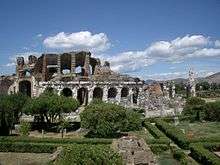Atella
Atella was an ancient Oscan city of Campania, halfway between Naples and Capua.[1]
Its ruins lie between the towns of Orta di Atella and Sant'Arpino.
History
Atella is not mentioned until the Second Punic War, when, although an independent city striking its own coinage, it was allied with Capua and the other Campanian cities in siding with Carthage after the battle of Cannae.[2] It was occupied by Rome in 210 BC, the chief citizens executed and the survivors enslaved or exiled; the city was refounded as a home for the refugees from Nuceria.[3] In the 1st century BC, Cicero speaks highly of it[4] and appears to have been its patron; it continued into imperial times as a municipium, famed for its traditional scenic performances known as Atellanae.
In the slave revolt of Spartacus, the slave army was brought to the city after they defeated Lucius Furius and Lucius Cossinius in Nuceria. Near the city, a fight broke out between the rebels and a Roman force.
Ecclesiastical history
The Christian bishopric with see at Atella (or rather modern Orta di Atella) dates back, according to recent hagiography, to a bishop named Canio, martyred under the Roman Emperor Diocletian in about 300 (traditionally 313 AD). The Greek legend of Saint Januarius mentions a bishop of Atella as one of those who accompanied the relics of that saint to Naples. A later bishop of Atella named Elpidius built a church over the tomb of Saint Canio and in the 9th century the cathedral of Atella was dedicated to himself as Saint Elpidius. In two of his letters, Pope Gregory the Great (590 to 603) mentions a Bishop Importunus of Atella. The relics of Saint Canio were moved to Acerenza in 799 and those of Saint Elpidius were taken to Salerno, probably because of the destruction and insecurity caused by the wars between Byzantines and Lombards. The diocese of Atella continued to exist until it became one of those incorporated into the new see of Aversa, founded in 1053.[5][6][7] No longer a residential bishopric, Atella is today listed by the Catholic Church as a titular see.[8] The town has a former cathedral, the 14th-century duomo of Santa Maria da Nives.
Titular see
The diocese was nominally restored in 1968 as Latin Catholic titular bishopric.
It has had the following incumbents, of the fitting episcopal (lowest) rank with an archiepiscopal (intermediary) exception :
- Giuseppe Ruotolo (1968.11.09 – 1970.06.11)
- Vittorio Piola (1970.07.18 – 1972.02.15)
- Decio Lucio Grandoni (1972.07.22 – 1974.12.12)
- Clemente Riva, Rosminians (I.C.) (1975.05.24 – 1999.03.30)
- Titular Archbishop Luigi Bonazzi, Apostolic Nuncio (papal ambassador) to Canada
Remains
The ruins of the city walls, private houses and many tombs remain, on sites in the comuni of Frattaminore, Orta di Atella, Sant'Arpino and Succivo, the last three of which formed the comune of Atella di Napoli in the mid‑20th century. The territory of ancient Atella is now in the comuni of Caivano, Cardito, Cesa, Frattamaggiore, Grumo Nevano and Sant'Antimo.[9]
Notes
- ↑ Tabula Peutingeriana; William Smith, ed. A Dictionary of Greek and Roman Geography (1878) s.v. "Atella"
- ↑ Livy, ii.61; Silius Italicus, Punica xi.14, noted in Smith 1878.
- ↑ Smith 1878.
- ↑ Cicero, De leges agr. ii.31, familiar letters
- ↑ Francesco Di Virgilio, La Cattedra aversana: Profili dei vescovi, 1997
- ↑ Gaetano Parente, Cenno storico sulla cattedrale di Aversa, Napoli 1845
- ↑ Konrad Eubel, Hierarchia Catholica Medii Aevi, vol. 1, pp. 122–123; vol. 2, p. 100; vol. 3, p. 126; vol. 4, p. 106; vol. 5, p. 109; vol. 6, p. 111
- ↑ Annuario Pontificio 2013 (Libreria Editrice Vaticana 2013 ISBN 978-88-209-9070-1), p. 841
- ↑ See those comuni.
Sources and External links
Coordinates: 40°57′30″N 14°15′30″E / 40.9583°N 14.2583°E



